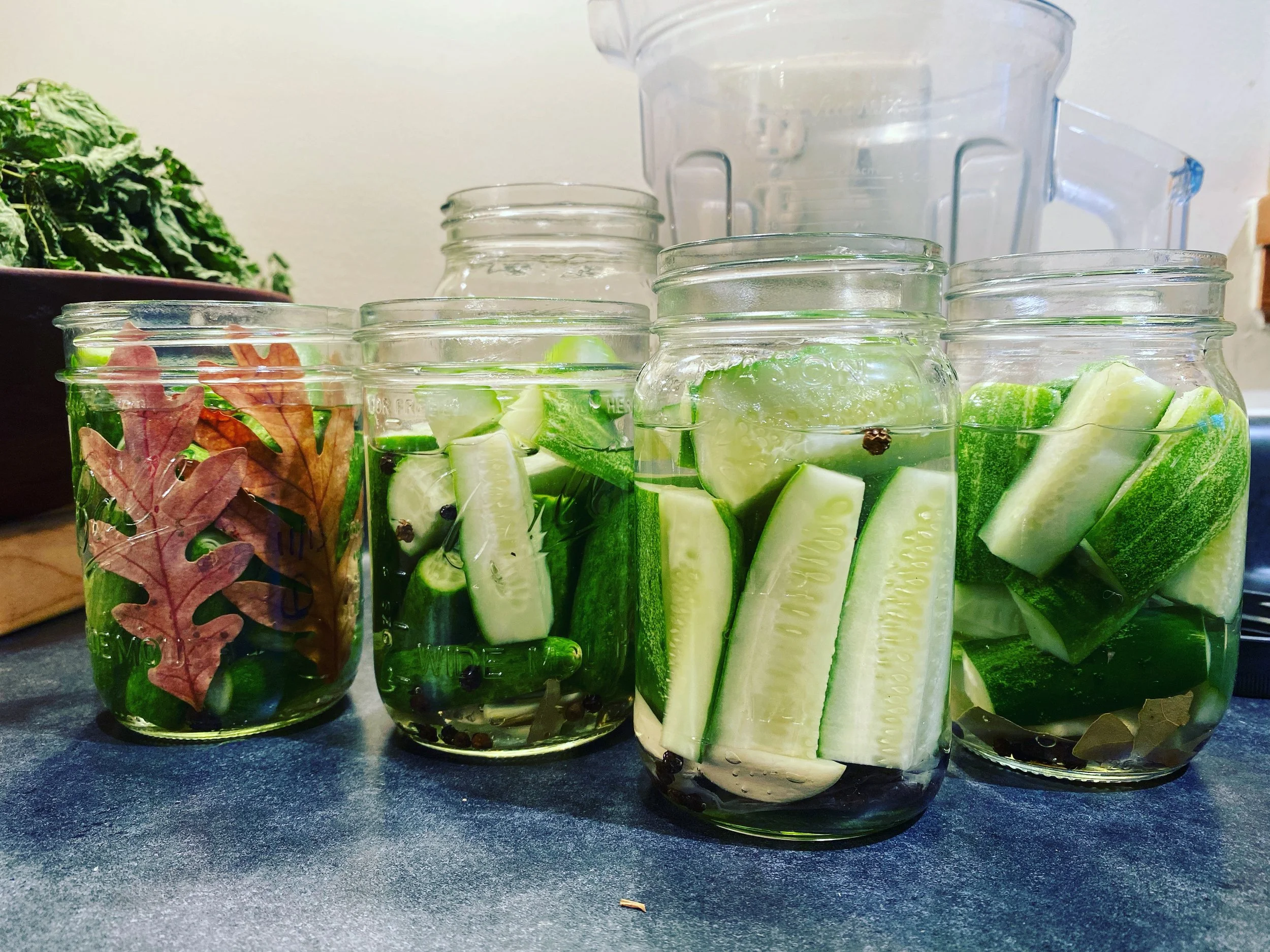What’s the difference between refrigerator pickles and lactofermented ones? Flavor and Probiotics! Also tannins, time, and a lot of culinary satisfaction.
Ingredients:
Cucumbers; I like to get the 12 oz package of tiny little cukes, but I have also used the 5-6 inch ones (4 -5 of those are around 12 oz). This will make about 2 pint jars of pickles. Fresher vegetables give you better pickles.
water (I use tap, but you could use bottled or distilled)
salt (I use plain white salt, but you can get fancy)
garlic cloves (4 or more, optional)
black peppercorns - a few shakes
fresh or dried herbs of your choice (dill, thyme, bay leaf)
vinegar (plain white, red wine, or apple cider)
liquid from a previous fermentation (sauerkraut, fermented veggies, yogurt whey, previously fermented pickles)
tannin provider* (bay leaf, oak leaf, grape leaf, black tea bag) Phenol-containing plant that will keep your cukes crisp.
Equipment:
2-3 pint jars and lids. I like the narrow mouthed jars more than the wide-mouthed ones - I can wedge the pickles in under the shoulders of the jar to keep them submerged. But really, whatever jar and lid you have is fine.
Instructions:
1) Wash your cukes, and trim about 1/4 inch off each end - focus on the blossom ends. Why? This end has enzymes in it that will cause your cukes to lose their crunch. Boo - floppy pickles are no fun. If using the larger cucumbers, quarter them, or cut them into whatever shapes you fancy (coins?) but be sure that they fit into the jar to leave about an inch of head room. Put your cukes in an ice water bath for 30-60 minutes to crispen them up.
2) Make 2 cups of 5% brine; 1.5 tablespoons of salt dissolved in 2 cups of water. If you wish to measure, 25 grams salt / 2 cups water (which is 500 ml). You could go lower to a 3.5% brine, which will give you a shorter ferment. It’s up to your taste preference.
3) In the bottom of each jar, put 2 whole cloves of garlic (or more!, or less), a few black peppercorns, the tannin choice and any fresh herbs. If I’m using an oak leaf, I will stand it up the side because it is so beautiful. If making a large batch in a 4 C mason jar, you could also cut a head of garlic in half and put it in for its beauty.
4) Put your cukes in the jar - I like them standing up and wedged in so they cannot float free. It’s important to keep them submerged to avoid air contact, which could result in surface fungus contamination.
5) Pour 3% brine into the jar until it’s 3/4 full. Add 1/4 c of vinegar and pour in a dollop of backslop (liquid from a previous fermentation). Top off with enough brine to ensure everything is submerged. If things insist on floating, you can get creative with submersion devices.
I have used a bar or round of carrot or parsnip wedged below the shoulders of the jar, under the liquid’s surface.
Crumple up a cabbage leaf and put it in the top of the brine. Some of it will stick out and contact the jar lid. If it gets wierd or fuzzy, pull it out, wipe off the upper inner surfaces of the jar, maybe top it up with some more brine and and put in a new crumped leaf. Keep fermenting!
A clean stone (put it through the dishwasher) or fermentation weight that fits into the top of your jar will keep things underwater.
A clean film of plastic on the top of the liquid might work, but for me, this was the least successful.
6) Label your jars with content and date, and put them in a dark cool place - I keep them in a cupboard under my counter.
7) Check your ferment every day to ensure submersion. This is really important - keep them under the liquid surface, otherwise mold might happen. If you do get a slight whitish film on top, blot with paper towel, wipe around the inside, change the lid, and top up with brine. You will not get all the mold spores, but you’ll hopefully keep the superficial fungus at bay until your preferred underwater ferment is complete. Putting the pickles in the fridge will slow all fermentation down to a crawl, so any fungus issue will disappear.
After a few days, do a taste test of part of a pickle. They are done when you like their flavor - for me, it takes about 7-10 days. If you want a tangier pickle, wait longer! If a longer wait vies you a softer pickle, next time try a higher % brine - go for 4/5%. Remember that cucumbers are mostly water, so that the brine becomes diluted when you add the veggies.

